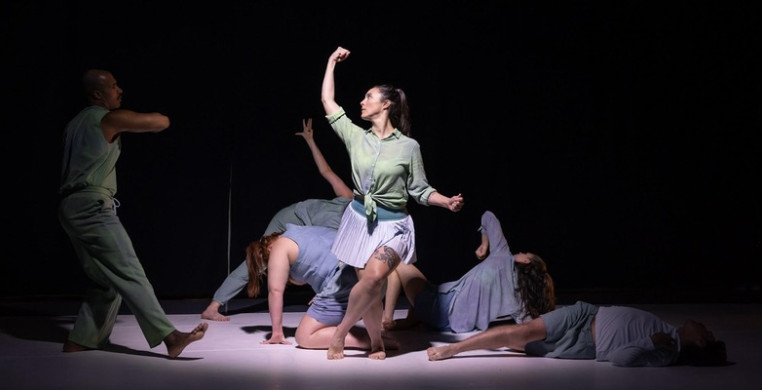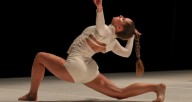In an innovative celebration of dance, Dovetail Studios and Same Planet Performance Project (SPPP) launched the "3320 Series," a two-weekend showcase of the depth and diversity of Chicago's dance scene. The November 1st lineup featured performances by seasoned artists Bob Eisen and Terrance Marling with a premiere work by SPPP. Set in the intimate black box theater at The Garage, the evening provided an immersive experience, allowing the audience to connect deeply with the artistry just three feet away.
The evening opened with “33 Years Later,” a duet performed by Bob Eisen and Joanne Barrett. While the origins of the title remain unclear, Eisen's impact on the Chicago dance community spans over 40 years. As co-founder of Links Hall in 1978, he significantly shaped the landscape of performance and creative space in the city.
The duet offered a poignant exploration of the aging body within dance. Rooted in classic modern dance aesthetic, their performance was beautifully intertwined with the fluidity and tactile elements of contact improvisation. They navigate the stage, Barrett in sweeping passes while Eisen walks with an uneven gait and bouncy movements of the head and arms, their aged bodies telling a story of resilience and vulnerability. While Barrett moves with grace and control, Eisen moves with jerky and staccato energy, leaving the impression that he may not be in control of his body the entire time.
The accompanying soundscore of radio static and white noise played through two vintage antennae radios created a backdrop that enveloped the dance performance in a veil of uncertainty, highlighting the blurred boundaries between sound and silence. “33 Years Later” invites the audience to reflect on the beauty of aging, the evolution of the body and the enduring power of dance as a means of expression and connection.
 Same Planet Performance Project; Photo by Vin Reed
Same Planet Performance Project; Photo by Vin Reed
Terrance Marling’s solo performance “Ham and Cheese” seamlessly blends three solos choreographed over the past decade. From the moment Marling steps onto the stage, his stoic presence commands attention, while his expressive movements draw the audience into a deeply personal narrative. The choreography merges contemporary gestural movement with breathtaking ballet, showcasing Marling's technical skill and mastery of his body. His fluid transitions between grounded gestures and grand leaps celebrate the joy of movement, with each pirouette feeling like a triumph.
Interludes throughout the piece offer insights into nurturing and parenting. The first features the sound of a crying child, with Marling rushing to cradle an imaginary infant, while the second includes a voiceover of his struggles with De Quervain's Tenosynovitis, known as “mommy’s wrist.” When choreographing for another dancer, as Marling did with these solos, careful attention is paid to their abilities and reactions. Marling's interludes on children and maternity poignantly highlight this connection, emphasizing the profound relationship between nurturing individual potential and the collaborative nature of choreography.
SPPP closed out the evening with the premiere of “Flack,” a word that has multiple meanings revolving around themes of resistance and response. Informally, it signifies criticism or backlash, reflecting societal pushback against individual choices, while in a military context, it refers to anti-aircraft fire aimed at downing enemy aircraft, representing direct opposition. Both meanings highlight the targeting of perceived threats, whether in discourse or warfare, illustrating the challenges of standing out and confronting the status quo.
 Same Planet Performance Project; Photo by Vin Reed
Same Planet Performance Project; Photo by Vin Reed
"Flak" embodies these themes through its dynamic movement and innovative sound score. Dancers navigate the stage with sharp, aggressive choreography that reflects the barrage of flak one might face in both personal and societal contexts. As their bodies clash and converge, the interactions evoke a sense of struggle and defiance, embodying the pushback against perceived threats. The jarring soundscape—featuring orchestral instruments playing in no obvious meter, a small ensemble of female voices singing as if casting a spell and unsettling electronic tones—intensifies the experience, creating an immersive environment that might make the audience uncomfortable — at one point, a high pitched tone fills the space similar to tinitus.
The ending of "Flak," performed by Patrick Burns and Kathryn Herrick, has dancers violently writhing on the floor. As they stand up, their breathing becomes heavy, and they vigorously rub their chests, shifting into large skips across the space. This struggle gives way to a fleeting moment of stillness, quickly shattered by percussive stomps and flailing limbs that re-energize their surroundings. The dynamic shifts dramatically as one dancer collapses while the other circles like a vulture eyeing its prey. The piece culminates abruptly with a slamming door and a sudden blackout, leaving the audience in stunned silence.
Through "Flak," the performers articulate a dialogue about the complexity of resistance, highlighting how humanity engages in a continuous dance of conflict and resolution. The pastel-colored costumes of the dancers starkly contrasted with the intense themes of the performance, creating a dissonance that led the audience to a false perception of lightness amid the underlying turmoil. The lighting design by Jacob Snodgrass illuminated the stage, casting sharp contrasts and shadows that accentuated the tension between the dancers, highlighting their struggle and dynamic interactions within the space.
The "3320 Series" offered a captivating blend of movement and storytelling that not only highlighted the exceptional skill of veteran dancers and choreographers but also enriched the conversation about the human experience through dance. From intimate reflections on aging to heartfelt explorations of nurturing and personal growth, the evening provided a nuanced meditation on the body, time and resilience, and the works pushed boundaries with their provocative themes of resistance, struggle and the complexities of societal conflict.
The “3320 Series” was presented on Nov. 1 at The Garage at Dovetail Studios, 2853 W Montrose. The event is planned to be held annually. To find out more visit www.dovetail-studios.com or click the company link below.


